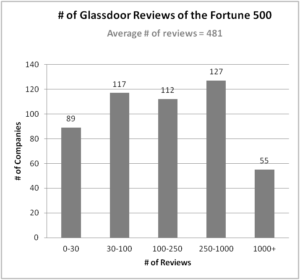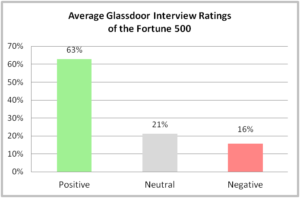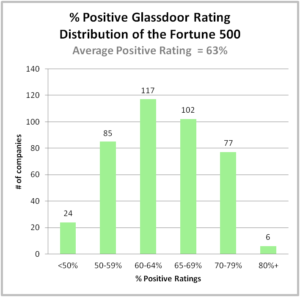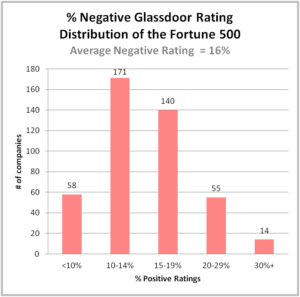Over the past couple of years I have noticed a dramatic increase in the attention recruiters are placing on Glassdoor feedback. Some talent acquisition organizations are even including their Glassdoor interview ratings in their corporate metrics. Others are looking to find ways to increase the number of interview reviews. Given the greater emphasis and priority being placed on the candidate experience, I thought I would research the interview performance of the Fortune 500. Here is what I learned:
- The average number of interview reviews is 481, but most have less than 154 reviews
There is a wide distribution in the number of interview ratings, with about 10% of companies having more than 1000 reviews, however, many organizations do not even have 30 reviews. The mode number of Fortune 500 Glassdoor interview reviews is only 154, thus half of the F500 have less than 154 interview reviews

- Not surprisingly, for most companies, only a small fraction of candidates leave feedback, but have a big impact on company perception
The average number of employees in the F500 is about 69,000. Assuming 15% of the total workforce is close to the number of annual hires, and each filled-position interviewed 2.5 candidates, then, on average, 25,000 candidates are interviewed each year for an F500 company. With a mean of 481 cumulative reviews collected since Glassdoor started, then it is easy to see how less than 1% of interviewed candidates actually post feedback on Glassdoor. Thus, similar to Yelp, the critical few have a big impact on the many candidate readers.

- The average positive experience across the Fortune 500 is 63%
I have heard many recruiters hypothesize that most candidates only go to leave feedback on Glassdoor if they had a bad experience. The data clearly does not support this perspective.
In fact, the mode is also 63%, thus almost two-thirds of all reviewers had a good interview experience. On the flip side, there are only a handful of companies who crossed the 80% positive threshold. This tells me that there is still long way to go for almost every company to improve their candidate interview experience.
Note: Graphic excludes 19 companies where the number of reviews was less than 30.

- The average negative experience across the F500 is 16%
While a 16% mean negative rating may not seem like much, let’s look at the math if you are a consumer-oriented company. If a company is interviewing 25,000 candidates, and the 16% is a statistically representative sample, then about 4000 candidates are unhappy with their experience. Not only might they tell friends and colleagues about their bad experience which impacts other potential hires, but losing even half of those customers (2000) for a lifetime could be worth millions of dollars in lost revenue. It’s pretty easy to do the math on why investing a little more in the candidate experience has a positive ROI.
Note: Graphic excludes 19 companies where the number of reviews was less than 30.

- Glassdoor’s feedback methodology isn’t that helpful for employers.
While I realize Glassdoor wants to make it super-simple for candidates to submit feedback there are a couple of glaring issues with the form for how employers can use the data. The 3-point scale ‘Rate the Overall Experience’ is oversimplified to provide differentiated statistics. Using the Net Promoter Score scale would provide more meaningful, standardized data to use for analysis. Similarly, Glassdoor’s current method of capturing open-ended feedback relates to their ‘Describe the Interview Process’ question with additional ‘Briefly describe the interviewing and hiring process’. While this is helpful to set expectations for other candidates to know what to expect, it does not consistently guide candidates to detail what went well and didn’t go well for their interview experience. Here are some good examples where candidates detailed answers were very helpful. Unfortunately, a majority of the time, candidates detail the process steps without adding an explanation for their rating. Putting in an additional text field after the rating scale with the question ‘Why did you give this rating?’ would be helpful to both candidates and employers.
- It only takes one person to create a negative candidate experience
After reading hundreds of negative reviews, one pattern that I noticed, is that many times a candidate detailed interactions with several interviewers and had multiple positive experiences. But then it took just a single bad event, like an interviewer acting unprofessional (e.g. didn’t read their resume before showing up, didn’t apologize for being late etc.) or the recruiter didn’t follow-up in a reasonable amount of time for all that goodwill to be forgotten. This shows how a great candidate experience is only as strong as its weakest link.
- Three companies with great interview ratings :
As mentioned above, I would expect a consumer-oriented brand would strive to be above average in their interview ratings. Three of the companies with a large number of reviews and stellar ratings are in that category:
- Deere (81% Positive / 7% Negative)
- Publix (81% Positive / 8% Negative)
- Southwest Airlines (79% Positive / 8% Negative)
- Three companies with surprisingly below average ratings:
- Aflac (46% Positive /25% Negative)
- Dish Network (49% Positive /27% Negative)
- Netflix (38% Positive / 34% Negative)
Interestingly, all three have a consumer-orientation which means that many of the candidates they interview are potential customers they might lose for a lifetime.
Netflix is especially curious because of how much press they have received about being a progressive company with their HR practices and forward thinking culture. While the bar may be high to join the company, given the subscription nature of their offerings, one would think they would invest a lot more in ensuring a great candidate experience. (Note: I interviewed at Netflix back in 2002 and had a great experience. I still remember the process in detail, including some elements which I have since borrowed when I conduct my own candidate interviews).
So what’s the opportunity for your company?
My key take-away from this analysis is that it is still early in the game for companies to shape and change their Glassdoor interview ratings and reviews. By both improving their candidate experience and leveraging new ways to encourage candidate to leave feedback, employers can drive up their positive feedback rates to improve their employer brand and candidate perception.
About the Author: Ray Tenenbaum is the founder of Great Hires, a recruiting technology startup offering a mobile-first Candidate Interviewing Experience platform for both candidates and hiring teams. Great Hires was named as one of Entrepreneur Magazine’s Brilliant Companies of 2016 where it was ranked #2 in Business Tools. Follow Ray on Twitter @rayten or connect with him on LinkedIn.